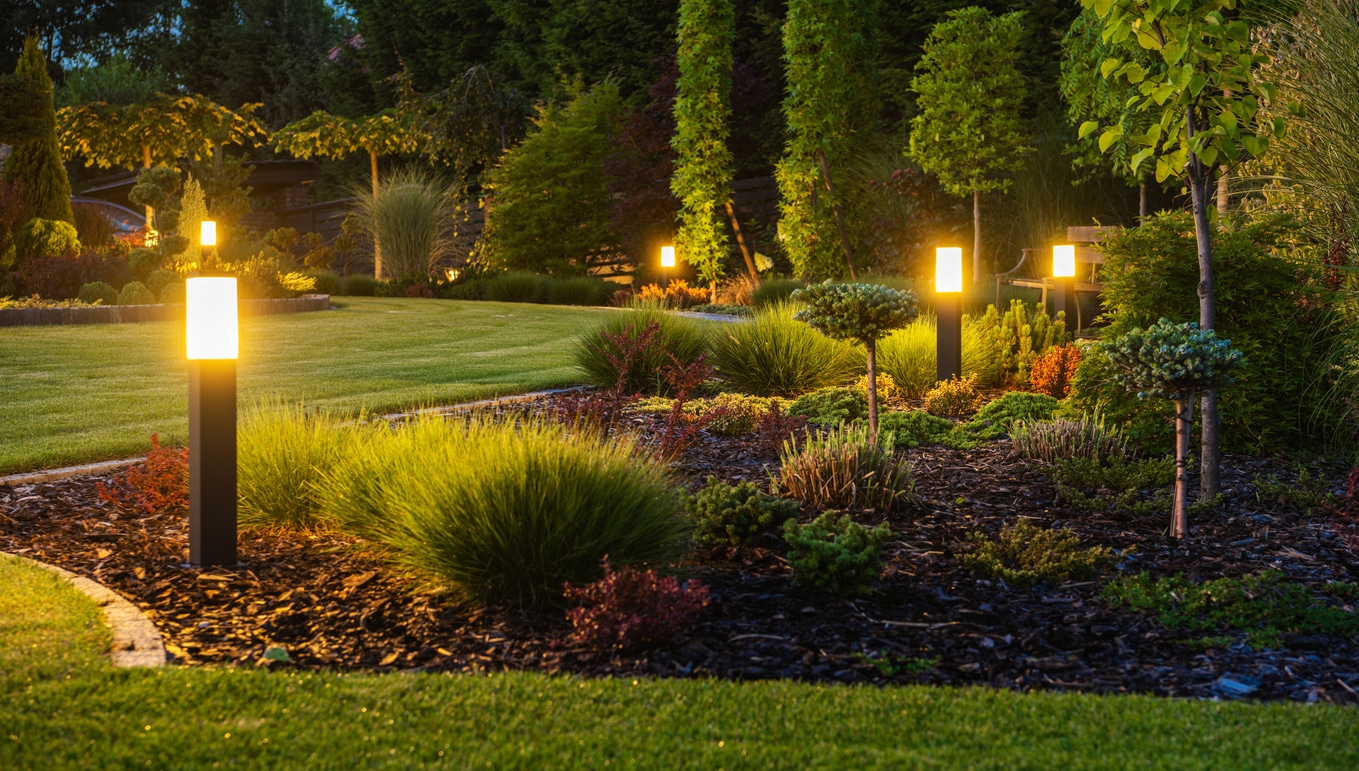When most people think about transforming their outdoor spaces, they picture lush gardens, custom stone patios, or stylish retaining walls. But one often-overlooked element—exterior lighting—can be the key to tying everything together. Proper outdoor lighting enhances functionality, creates ambiance, improves safety, and highlights the best features of your landscaping and hardscaping after the sun goes down.
From residential backyards to commercial outdoor environments, exterior lighting plays both a practical and artistic role in outdoor design.
Why Exterior Lighting Is Essential
Extends Usability of Outdoor Spaces
Your outdoor living areas—patios, decks, gardens, and walkways—shouldn’t be limited to daylight hours. Lighting allows you to cook, entertain, and relax well into the evening.
Whether you’re hosting guests around a fire pit, dining al fresco, or simply enjoying a quiet evening under the stars, properly placed lighting makes your space usable without being harsh or overpowering.
Examples:
- Downlights over outdoor dining tables
- Soft illumination under outdoor kitchen counters
- Lighting zones controlled independently for flexibility
Improves Safety and Navigation
A poorly lit yard is more than an inconvenience—it’s a safety hazard. Uneven surfaces, steps, and low walls can easily become tripping points in the dark. Outdoor lighting enhances visibility and makes your home easier to navigate, especially for guests unfamiliar with the layout.
Key Safety Lighting Areas:
- Entryways and doorsteps
- Walkways and garden paths
- Stairs (stone, wood, or concrete)
- Driveways and transitions between surfaces
Motion-activated lighting can also be used to temporarily light areas when movement is detected, adding both convenience and efficiency.
Enhances Security
Exterior lighting acts as a natural deterrent for trespassers or unwanted wildlife. A well-lit perimeter reduces hiding spots and makes it easier to monitor activity around your property.
Security-focused lighting may include:
- Motion-sensor floodlights near garages or rear entrances
- Low-voltage lights around fencing or gates
- Illuminated house numbers for emergency responders
Combined with landscaping and hardscaping features like fencing or retaining walls, lighting creates a secure and well-defined outdoor environment.
Lighting Design as Part of Your Landscape and Hardscape Plan
Lighting should be integrated from the very beginning of your outdoor design process—not added as an afterthought. When considered during the design phase, lighting can be incorporated directly into hardscape elements and enhance the intended flow and mood of the space.
Landscaping + Lighting:
- Highlight flowering beds and ornamental trees with uplighting
- Use moonlighting (fixtures mounted in trees) for a natural glow
- Create focal points in the yard with spotlights
- Accentuate textures in foliage, bark, or stone with directional lighting
Hardscaping + Lighting:
- Integrate under-cap lighting into retaining walls and seating walls
- Place LED paver lights within patios or walkways
- Add step lights into stone staircases or risers
- Install pillar lights on columns and entry posts for ambiance and orientation
This combined approach elevates your entire outdoor design, creating a balance between hard surfaces, soft landscaping, and the interplay of light and shadow.
Types of Exterior Lighting Fixtures
Choosing the right type of fixture is crucial for achieving both visual effect and functional performance. Here are a few commonly used options:
- Path Lights: Illuminate walkways, driveways, and garden borders to improve visibility and create subtle ambiance.
- Spotlights: Direct a focused beam of light to highlight specific features like trees, sculptures, or architectural elements.
- Wall Lights: Mounted on vertical surfaces such as retaining walls, fences, or structures to provide accent or area lighting.
- Well Lights: Installed flush with the ground for uplighting trees, shrubs, or the façade of a house without visible fixtures.
- Step Lights: Built into stair risers or side walls to ensure safety while enhancing the look of stone or wood steps.
- Flood Lights: Provide broad, high-intensity coverage ideal for illuminating driveways, garages, open yards, or high-traffic areas.
Each fixture serves a unique purpose and contributes to the overall function and aesthetic of your outdoor space. The right combination of these can create a layered lighting design that enhances safety, style, and usability.
LED and Low-Voltage Lighting: The New Standard
Modern exterior lighting systems rely heavily on low-voltage LED technology, which offers a range of benefits over traditional lighting:
- Energy Efficiency: Uses less electricity than halogen or incandescent bulbs
- Longevity: LEDs can last up to 50,000 hours, reducing replacement needs
- Safety: Low-voltage systems (typically 12V) are safer for outdoor environments
- Smart Controls: Many systems integrate with Wi-Fi or smart home platforms for automated scheduling and remote access
Lighting zones can also be programmed with timers or sensors, reducing light pollution while maintaining security and ambiance.
Seasonal and Environmental Considerations
In colder climates, exterior lighting plays a critical role in the winter months when daylight is limited. Illuminated walkways, driveways, and entrances are especially helpful during snowy or icy conditions.
In warmer seasons, lighting highlights landscaping at its peak—like blooming perennials, mature trees, or a freshly mulched garden. Additionally, well-placed lighting allows your outdoor features (fire pits, pergolas, water features) to shine long after sunset.
All fixtures should be weather-rated for durability and installed with drainage in mind to withstand seasonal conditions.
Light as a Design Element
Just as you plan the layout of your patio or choose the right plants for your soil type, lighting should be selected with intention. It serves as both a tool and an art form—shaping how people move through a space and how they feel within it.
When paired thoughtfully with hardscaping and landscaping elements, exterior lighting does more than “brighten up” a yard—it creates a mood, highlights craftsmanship, improves safety, and turns your property into a cohesive experience from day to night.
Thinking About Outdoor Lighting?
If you’re planning a landscape or hardscape project, don’t forget to include lighting in the conversation. Working with a professional ensures your system is designed for long-term performance, seamlessly integrated with your outdoor space, and tailored to your needs.
Whether you’re illuminating a stone patio, accenting a water feature, or lighting the way home, exterior lighting is one of the most valuable and transformative tools in any outdoor design.


